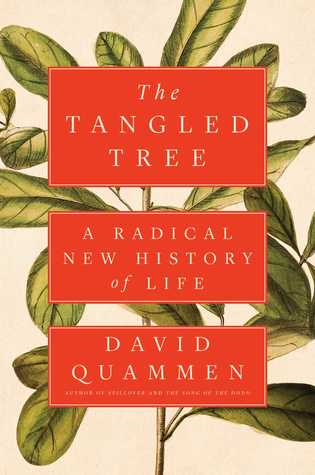
The Tangled Tree
A Radical New History of Life
کتاب های مرتبط
- اطلاعات
- نقد و بررسی
- دیدگاه کاربران
نقد و بررسی

March 15, 2018
With recent discoveries in molecular biology, life is beginning to look very different. In particular, horizontal gene transfer (HGT), the movement of genes across species lines, appears to be a significant aspect of evolution; about eight percent of the human genome derives not from inheritance but viral infection, a type of HGT. One consequence: the ascendance of antibiotic-resistant bacteria, which threatens human health today, is a direct result of HGT. From the winner of the NYPL/Helen Bernstein Book Award for Excellence in Journalism and a National Book Critics Circle finalist for Spillover.
Copyright 2018 Library Journal, LLC Used with permission.

Starred review from May 7, 2018
Science writer Quammen (The Song of the Dodo), as he has so often done before, explores important questions and makes the process as well as the findings understandable and exciting to lay readers. Here, he delves into the field of molecular phylogenetics, the process of “reading the deep history of life and the patterns of relatedness from the sequence of constituent units in certain long molecules,” namely “DNA, RNA, and a few select proteins.” Although the topic might seem arcane, he brings it to life by profiling many of the field’s most important players, including microbiologists Carl Woese and Ford Doolittle, and demonstrating how it has changed “the way scientists understand the shape of the history of life.” The breakthroughs Quammen describes include Woese’s classification of the archaea, a new category of living creatures made up of single-celled microorganisms, and Doolittle’s insight, recounted in an interview with the author, that genes can be transferred horizontally, between organisms (and not always closely related organisms) rather than simply between parent and offspring. The cumulative effect is to transform Darwin’s famous image of evolution as a straightforwardly branching “tree of life” into a “tangle of rising and crossing and diverging and converging limbs.” This book also proves its author’s mastery in weaving various strands of a complex story into an intricate, beautiful, and gripping whole. Agent: Amanda Urban, ICM.

June 1, 2018
A masterful history of a new field of molecular biology that has wide-ranging implications regarding "human identity, human individuality, [and] human health."In their evolution from a common ancestor, multiplying species branch and branch again, forming a "tree of life": a mainstay of biology teaching for two centuries that turns out to be wrong, writes bestselling National Geographic contributing writer Quammen (Yellowstone: A Journey Through America's Wild Heart, 2016, etc.) in this impressive account of perhaps the most unheralded scientific revolution of the 20th century. It's the result of a new area of study called molecular phylogenetics, which involves "reading the deep history of life and the patterns of relatedness from the sequence of constituent units in certain long molecules, as those molecules exist today within living creatures. The molecules mainly in question are DNA, RNA, and a few select proteins." After admitting that this is a mouthful, the author describes three surprising discoveries that paved the way. The first revealed that genes don't always move from parent to offspring. Sometimes organisms pass them back and forth, which is called horizontal gene transfer. Then researchers, led by the book's central figure, biophysicist Carl Woese (1928-2012), while comparing bacterial RNA, identified a group so different that they weren't bacteria at all but an entirely new kingdom: the Archaea. Finally, studies kept showing that bits of hereditary material simply float independently inside cells and regularly move to neighbors, other species, or even other kingdoms. No exception, the human genome is speckled with bacterial and viral DNA. The tree of life looks more like a web. An indefatigable journalist covering a revolution whose participants are mostly alive is an irresistible combination, and Quammen seems to have interviewed them all. A consistently engaging collection of vivid portraits of brilliant, driven, quarrelsome scientists in the process of dramatically altering the fundamentals of evolution, illuminated by the author's insightful commentary.
COPYRIGHT(2018) Kirkus Reviews, ALL RIGHTS RESERVED.

























دیدگاه کاربران